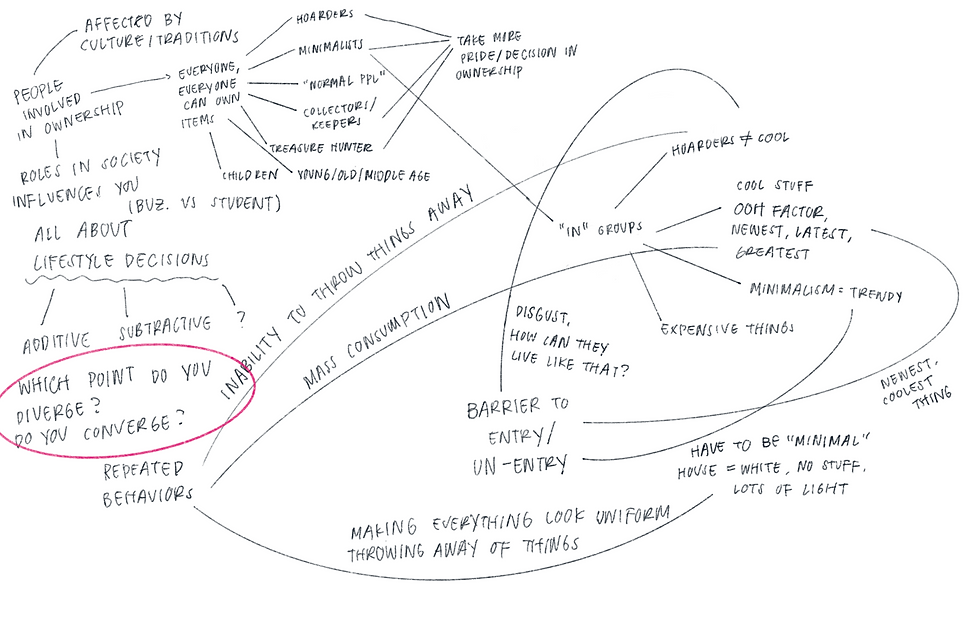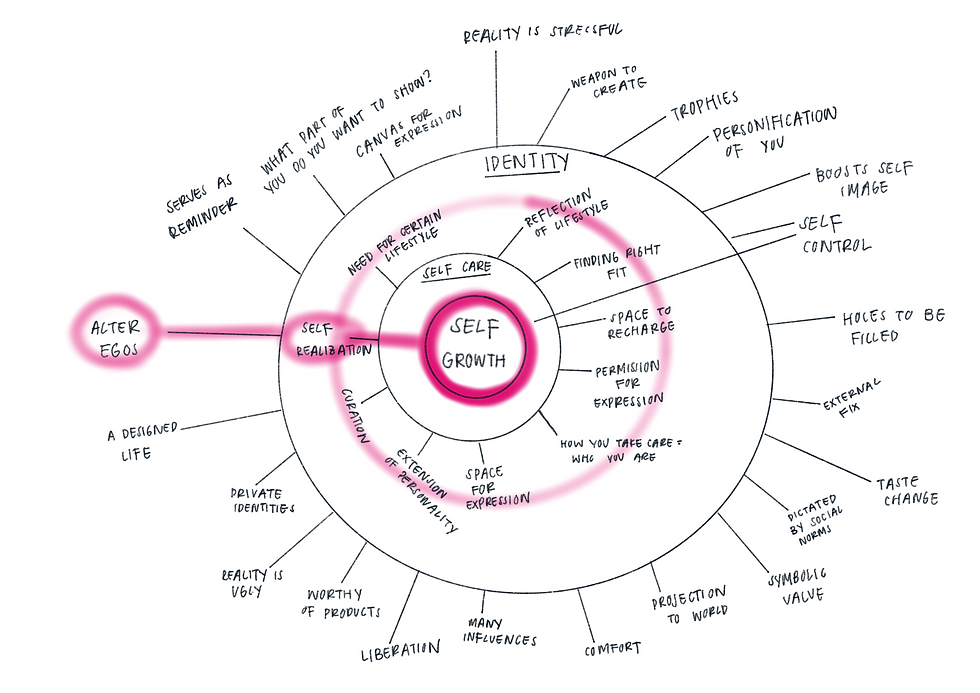What Does It Mean To Own Items?

what people say they do is not always what they actually do.
understanding why people do something is infinitely more important than merely knowing what they do.
In this advanced professional-level research course, we worked in teams to deeply investigate a chosen topic, learning to frame and design a research study. The course covers the creation of participant specifications, obtaining informed consent, and ethical research practices.
Using advanced qualitative methods and generative tools, we uncovered underlying issues such as attitudes and values, aiming to find insights that fuel viable design breakthroughs.



Project Type: Design Research
Date: Fall 2021
Duration: 14 Weeks
Researchers*: Annie Chen, Yunhao Song, Vincent Ye
*All researchers shared equal responsibilities throughout this project.
Reading Time: 10 Minutes
Our Participants
Participant Specification: Have lived in their homes for over 3 years
Expert Specification: Works in marketing or consumer research or is creative/art director
.jpeg)





Sarah
Parent & Tutor
"The standard is to be happy."
Brenna
Designer
"It's about having limitations."
Frido
Professor & Designer
"It's about finding the right fit."
George
Philosopher
"There is data behind objects."
Soya
Researcher
"My room is my personal universe."
Tom [Expert]
Chief Creative Officer
"Make me look, make me think, make me care."
03 Image Deck
Knowledge Goal: How do their view other people's attitudes and beliefs?
Participants were presented with a series of diverse images of home interiors, varying in style and cleanliness. They were asked to arrange these images in any sequence that resonated with them.

01 Photo Journal
Knowledge Goal: What is their motivation?
Before the interview, participants received a set of prompts and were asked to capture photos that reflected each one. This exercise aimed to explore their motivations for holding onto certain items, as well as what they valued or dismissed.

02 Dixit Card Deck
Knowledge Goal: What is their experience?
Dixit cards, featuring abstract images, are designed to evoke memories and associations. Participants selected three cards that symbolized the joy items could bring them.

Findings From Our Research
After conducting interviews, we utilized various analytical tools to uncover meaningful insights and identify actionable opportunities. These tools helped us visualize information in innovative ways, allowing us to organize and make sense of our findings effectively. The frameworks we employed include:
-
POEMS + A&I (People, Objects, Environment, Messages, Systems, Activities, Interactions): A user experience framework for mapping interactions and contextual relationships.
-
Ethnographer's Questions: A method to deepen understanding of behaviors, motivations, and cultural contexts.
-
Bourdieu's Four Forms of Capital: Analyzing social, cultural, economic, and symbolic capital to interpret underlying dynamics.
-
P.N.S.T.I.O. (Problem, Need, System Challenges, Themes, Insights, and Opportunities): A structured approach to identifying key challenges and framing opportunities.
This project emerged from our shared experiences as international students, where the concept of ownership often feels transient and short-term. Moving between countries and adjusting to new spaces highlighted the need to carefully consider what we own, why, and how the items serve us.
Conducted during the pandemic, this project also reflected a unique period where we had the downtime to reassess our needs and redefine what felt essential in our lives.
Our reflections align with broader trends during the pandemic: studies showed a widespread shift toward minimalism, with people re-evaluating consumption, simplifying their belongings, and focusing more on items that bring value and comfort. This period catalyzed a global trend in mindful ownership, making this project both personally and culturally relevant.






From the analysis, we grouped our findings into 5 key themes: Trend, Emotion, Identity, Responsibility, and Balance.
Theme 1: Trend
Trend influences how people view ownership.
Social media and targeted marketing strategies heavily shape how people view what they own, often creating a sense of belonging or identity through possessions that align with certain group ideals. This drive to fit in can lead individuals to acquire items that reinforce their association with specific communities or lifestyles. Minimalism, a trend that has remained influential for years, exemplifies this. It encourages people to limit possessions and prioritize “essential” items, reshaping ownership into something intentional and curated. As a result, trends don’t just influence what people own - they transform the meaning and purpose of ownership itself.
Theme 2: Emotion
Emotions dictate what we own and what we keep.
Emotions deeply influence what we choose to own and keep, shaping our relationship with possessions through personal and sentimental connections. Joy often drives us to hold onto items that spark happiness, serving as tangible reminders of positive experiences. Beyond joy, objects can carry profound meaning, representing significant moments, relationships, or achievements in our lives. Memories and stories are embedded within these possessions, transforming them into more than just material items - they become vessels of our personal history and identity. In this way, emotions don't just affect what we own; they redefine ownership as a deeply personal and meaningful expression of our lives.
Theme 3: Identity
Objects are a representation of who you are as a person.
Social media and targeted marketing strategies heavily shape how people view what they own, often creating a sense of belonging or identity through possessions that align with certain group ideals. This drive to fit in can lead individuals to acquire items that reinforce their association with specific communities or lifestyles. Minimalism, a trend that has remained influential for years, exemplifies this. It encourages people to limit possessions and prioritize “essential” items, reshaping ownership into something intentional and curated. As a result, trends don’t just influence what people own—they transform the meaning and purpose of ownership itself.
Theme 4: Responsibility
Having ownership means taking responsibility.
Responsibility plays a significant role in shaping how we view ownership, extending beyond the personal to encompass broader societal and environmental considerations.An abstract sense of ownership fosters a feeling of stewardship, where owning something implies a duty to care for it and use it thoughtfully. This responsibility extends into consumerism, encouraging individuals to consider the ethical and environmental impact of their purchasing decisions, from sourcing to disposal. On a larger scale, there is an inherited responsibility to the planet, where ownership is tied to sustainability and the need to preserve resources for future generations.
Theme 5: Balance
Finding the right fit.
Ownership can support self-care, as carefully chosen items bring comfort, convenience, or a sense of stability. At the same time, shifts in perspective can reshape our understanding of what truly matters, prompting us to focus on experiences, relationships, and intangible values rather than accumulating material possessions. Striking a balance between the tangible and the intangible ensures that what we own serves a purpose without overwhelming us, creating harmony between our physical and emotional needs. In this way, ownership becomes a thoughtful equilibrium, reflecting both practicality and personal fulfillment.

Opportunity & Insight Pairs From Themes

Theme 1: Trend
Opportunity
How might we promote and reward slow paced lifestyles?
Insight
We live in a fast-paced, swipe-driven world, constantly seeking new stimulation. This relentless need for novelty often leaves us feeling distant and disconnected from what truly matters. With limited time and energy, it’s essential that we invest both wisely, focusing on what genuinely enriches our lives.

Theme 2: Emotion
Opportunity
How might we digitize or transform the meaning behind products?
Insight
People tend to keep things long-term because of the meaning attached to them. It's the memory or sentiment behind the object that truly holds value, and often, people feel that holding onto the object is essential to preserving that memory.

Theme 3: Identity
Opportunity
How might we create neutral "vessels" that empower users to transfuse their own meaning into?
Insight
Ownership serves as a reminder of personal identity. While culture is constantly shifting and objects may lose their original significance, they gain deeper meaning when they become tied to personal stories and memories.

Theme 4: Responsibility
Opportunity
How might we deal with the emotional aftermath of impulsive shopping?
Insight
For some, owning objects provides immediate stress relief - a quick, external fix. However, this relief is often short-lived, leading to a cycle where the initial comfort gives way to more stress over time.

Theme 5: Balance
Opportunity
How might we turn abstract mindsets into something tangible?
Insight
We often think of ownership in physical terms - owning objects - yet ownership can also be abstract, such as adopting a particular mindset. Minimalism, for example, is about owning less materially and embracing a sense of fulfillment that is more spiritual and intentional.
What Is Ownership?

Ownership is more than just possessing objects; it is a reflection of who we are and the responsibilities we carry. It is an ongoing process of editing and organizing, striving to achieve balance in our lives. On the surface, ownership involves our choices as consumers and the items we surround ourselves with. Digging deeper, it is about embracing the meaning, emotions, and memories tied to those objects. Ownership becomes a creative act - a way to connect with the stories that matter and to preserve them for future generations.

Home
About
Contact
© 2035 by Annie Chen. All Rights Reserved.